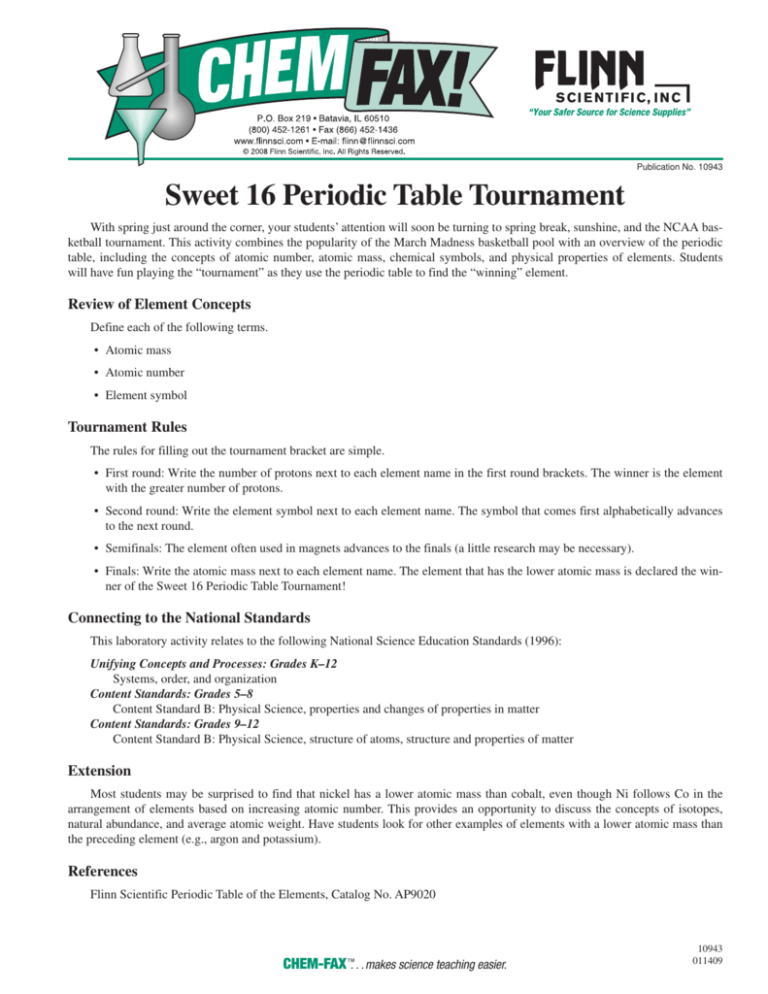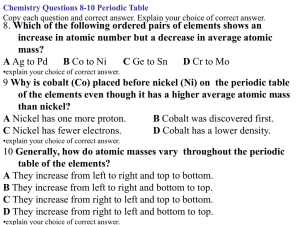
Publication No. 10943
Sweet 16 Periodic Table Tournament
With spring just around the corner, your students’ attention will soon be turning to spring break, sunshine, and the NCAA basketball tournament. This activity combines the popularity of the March Madness basketball pool with an overview of the periodic
table, including the concepts of atomic number, atomic mass, chemical symbols, and physical properties of elements. Students
will have fun playing the “tournament” as they use the periodic table to find the “winning” element.
Review of Element Concepts
Define each of the following terms.
• Atomic mass
• Atomic number
• Element symbol
Tournament Rules
The rules for filling out the tournament bracket are simple.
• First round: Write the number of protons next to each element name in the first round brackets. The winner is the element
with the greater number of protons.
• Second round: Write the element symbol next to each element name. The symbol that comes first alphabetically advances
to the next round.
• Semifinals: The element often used in magnets advances to the finals (a little research may be necessary).
• Finals: Write the atomic mass next to each element name. The element that has the lower atomic mass is declared the winner of the Sweet 16 Periodic Table Tournament!
Connecting to the National Standards
This laboratory activity relates to the following National Science Education Standards (1996):
Unifying Concepts and Processes: Grades K–12
Systems, order, and organization
Content Standards: Grades 5–8
Content Standard B: Physical Science, properties and changes of properties in matter
Content Standards: Grades 9–12
Content Standard B: Physical Science, structure of atoms, structure and properties of matter
Extension
Most students may be surprised to find that nickel has a lower atomic mass than cobalt, even though Ni follows Co in the
arrangement of elements based on increasing atomic number. This provides an opportunity to discuss the concepts of isotopes,
natural abundance, and average atomic weight. Have students look for other examples of elements with a lower atomic mass than
the preceding element (e.g., argon and potassium).
References
Flinn Scientific Periodic Table of the Elements, Catalog No. AP9020
CHEM-FAX姠. . .makes science teaching easier.
10943
011409
© 2008 Flinn Scientific, Inc. All Rights Reserved.
Nitrogen
Nickel
Lead
Mercury
Sodium
Silver
Magnesium
Aluminum
Copper
Carbon
Cobalt
Potassium
Phosphorus
Iron
Tungsten
Gold
First Round
Second Round
Semifinals
Winner
Rules
1. First Round — Element with more
protons wins.
2. Second Round — The winner is the
element with the symbol that is first
alphabetically.
3. Semifinals — Element often used in
magnets wins.
4. Finals — The winner has the lower
atomic mass!
Finals
Name: ____________________________________
Sweet 16 Periodic Table Tournament
–2–
10943
79
26
© 2008 Flinn Scientific, Inc. All Rights Reserved.
6
29
Carbon
Copper
28
7
80
12
13
19
15
74
11
47
82
Nitrogen
Nickel
Lead
Mercury
Sodium
Silver
Magnesium
Aluminum
27
Cobalt
Potassium
Phosphorus
Iron
Tungsten
Gold
First Round
Nickel (Ni)
Lead (Pb)
Silver (Ag)
Aluminum (Al)
Copper (Cu)
Cobalt (Co)
Iron (Fe)
Gold (Au)
Second Round
Nickel
Silver
Cobalt
Gold
Semifinals
Nickel (58.69)
Cobalt (58.93)
Finals
Nickel
Winner
Sweet 16 Periodic Table Tournament
Answer Key
–3–
10943







